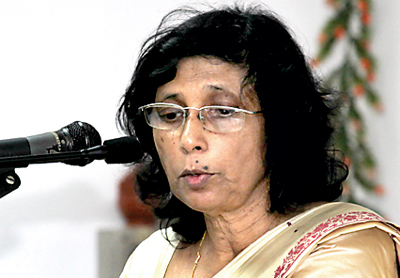Saving children: Stop the lip service, get down to business
Children have been dominating the news – the victims of rape, murder, incest and desertion even by those whose responsibility it is to safeguard them.
The platitudes have also been many, how children are the wealth and the future hope of the nation. But who has stepped out to take the interests not only of child victims but of all children as a whole under their wing?

Prof. Perera addressing the gathering. Pic by M.A. Pushpa Kumara
The answer up until Monday, December 3, was a sad but loud “None”. Not anymore, for on Monday, a group of like-minded and determined people did gather at the auditorium of the Lady Ridgeway Hospital, the premier children’s hospital in Colombo, to form the ‘Sri Lanka Association for Child Development’ (SLACD).
Many groups are working towards the welfare of children, but such efforts are taking place in isolation, the Sunday Times understands and the aim set out by those who mooted the SLACD was to bring not only these groups but anyone interested in working for the betterment of children under one umbrella.
SLACD will be the first professional association in Sri Lanka dedicated to child development, said Consultant Child Psychiatrist Prof. Hemamali Perera attached to the Colombo Medical Faculty, who is an initiator of the idea.
To show support for the cause, among the large gathering present at the inaugural meeting were Health Ministry Secretary Dr. Nihal Jayatillake, LRH Director Dr. Ratnasiri Hewage, World Health Organization Country Representative Dr. Firdosi Rustom Mehta, Sri Lanka Medical Association President Prof. Vajira H.W. Dissanayake, educational and social service officials and parents.
It will also not be limited to one sector but will bring together a multidisciplinary group “interested and skilled in child development”, including the medical profession, allied health groups, those involved in social work, education et al.
Asking what the development needs of the children are, Prof. Perera is quick to answer that the “common ground” that could be shared includes helping children reach their full potential, reducing vulnerabilities, promoting resilience as well as competence and self-reliance and essentially also promoting coping abilities to face the challenges of daily living and special situations.
SLACD’s mission is to promote, facilitate and support advancement of knowledge and skills, research and interest in development and developmental disorders in children and apply these for the welfare of children, their families and the community.
Citing one example with regard to “special children”, Prof. Perera set out the targets of SLACD as improving the level of detection and intervention, while also responding to demand and public expectation, building capacity and sharing resources and also playing a strong advocacy role. Another example was the need for children who do not fall into the “special” category, to improve their potential and hone their skills.
Among the strategies already on the table are promoting literacy in child development, developing assessment schedules and compiling an important and essential ‘Directory of Services’.
The SLACD will not allow any child to fall by the wayside, the Sunday Times learns, but encompass all…….children with chronic illness and disabilities, economically-deprived children, displaced children, children exposed to adverse experiences, street children, children in residential homes, children of “unavailable” or ill parents and gifted children.
Giving out an open invitation to everyone to join the SLACD, Prof. Perera’s passionate plea is – “All children have the right to receive the best opportunity for growth and development”.
That’s what the SLACD is endeavouring to do.
Their logo says it all
There is a tale behind the logo of the SLACD aptly designed by 14-year-old Navangi de Silva with the graphic being handled by medical student Nirmal Borukgama.
While the bud in the cage represents all the developmentally-challenged children in Sri Lanka, the blooming flower has broken through the bars to freedom. Both the bud and the flower sharing a common stem, however, symbolises the need and the ability for all children to have the freedom and upliftment to “bloom” to their full potential.
(For more information access www.slacd.org and if you wish to join the association please e-mail: info@slacd.org)
Follow @timesonlinelk






















